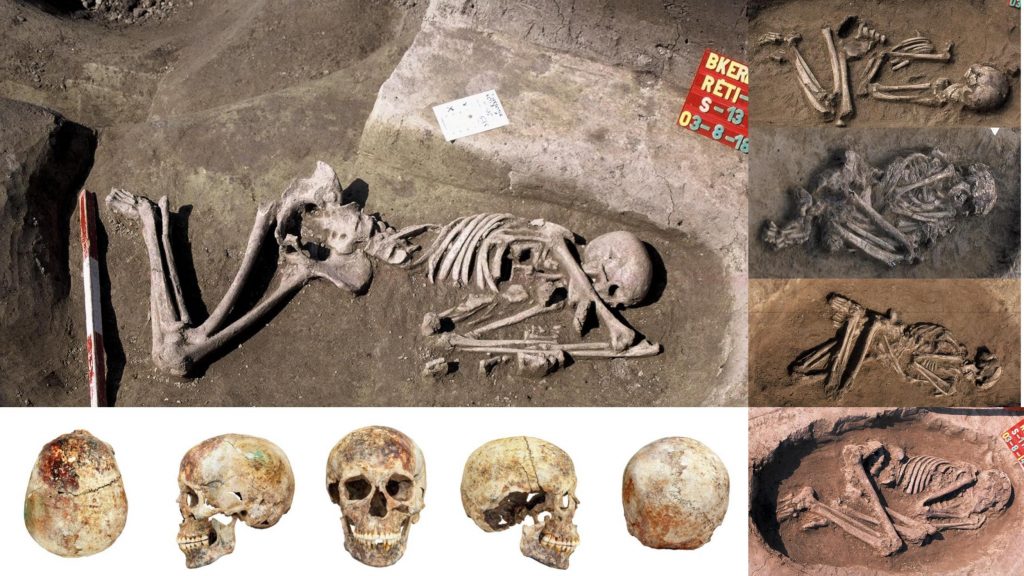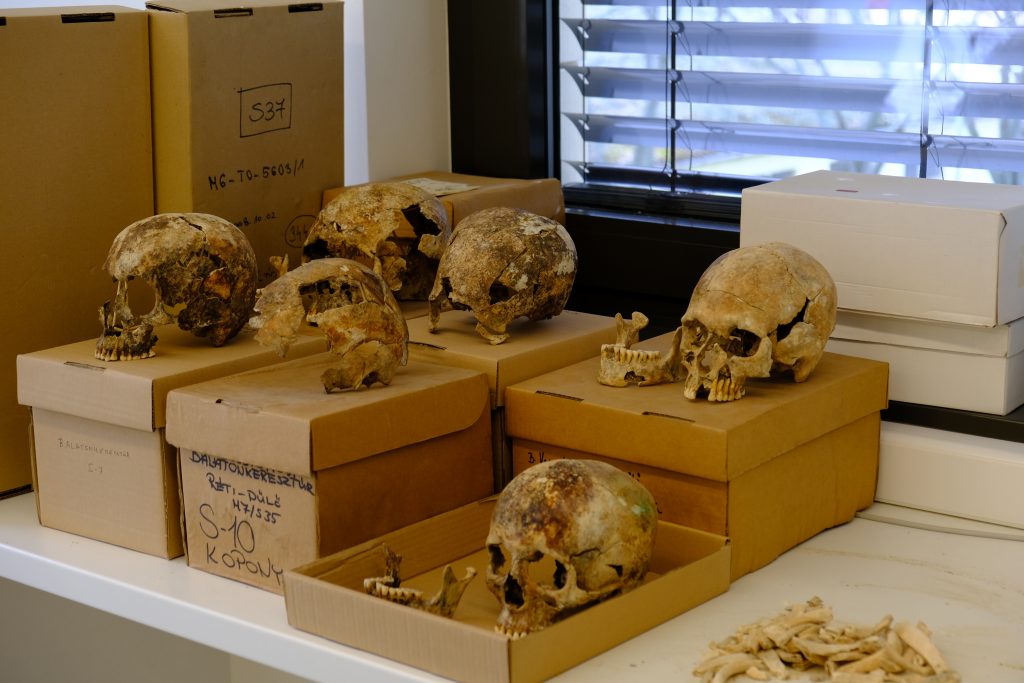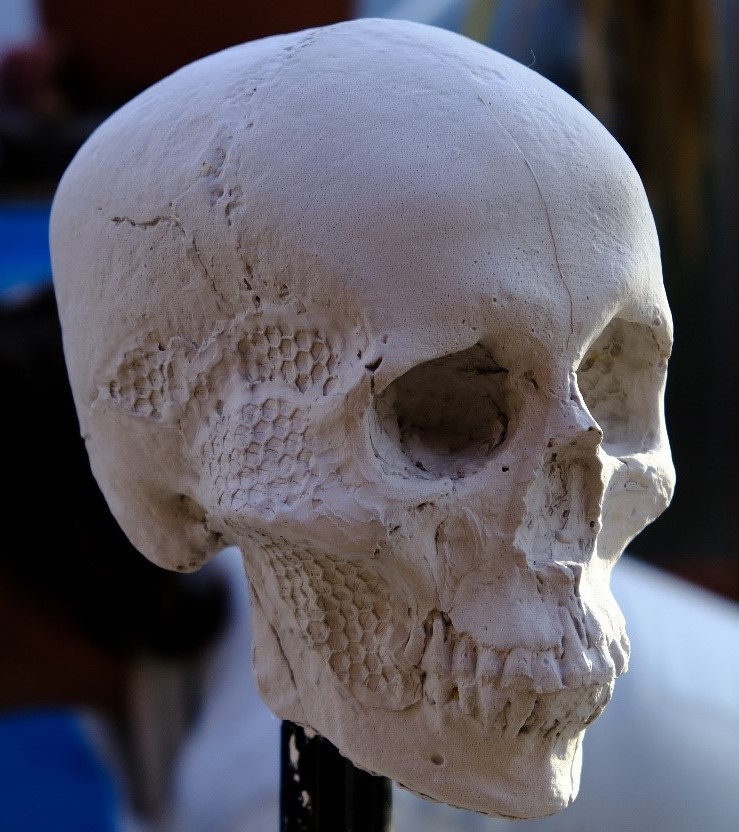Bronze Age embodied 3.1. Jelena from the southern side of Lake Balaton
In our series, titled Bronze Age embodied, we aim to highlight the conditions of life and death of women and men from the first thousand years of the Bronze Age (2500–1500 BC), based on findings (e.g. ceramic vessels, bronze ornaments or tools) and human remains of a particular Bronze Age burial. This time we recall the memory of a woman found in a burial excavated in Balatonkeresztúr.
Excavations of the highway roadworks in Balatonkeresztúr Réti-dűlő site (Western Hungary) between 2003 and 2004 revealed graves and settlements of the Early and Middle Bronze Age among the finding of other periods (excavation leader: Szilvia Fábián, excavated are: 45.000 m2, 2976 archaeological featires; Honti et al. 2004, 13, III.t.2; Honti et al. 2006, 26-29, 42-44; Fábián, Serlegi 2009).
The burial group included eleven individuals lying on their side for eternal sleep in mostly flexed position, often with hands in front of their face. Beside single graves, two household refuse pits also contained one and eight bodies, respectively (Fábián 2007, Köhler 2007). Most of the burials lacked any grave goods, except grave 10 and 13: the former, the burial of a child contained a bracelet, while in the latter, under the head of an adult woman the fragments of a bronze or copper bead were discovered. The burials were supposed to belong to the Early Bronze Age based on the mentioned finds (the summary of similar graves from this period see: Kiss 2020). Radiocarbon dates of the human bones revealed that the single inhumations and the pit burials can be dated between 2500 and 1640 BC.

Balatonkeresztúr-Réti-Dűlő site, grave 13 and the skull from this grave; other inhumations from the Early Bronze Age cemetery (photo: Szilvia Fábián, Dániel Gerber)
Middle-aged woman with a strange posture
The burial of the woman, buried on Grave 13 with a copper or bronze bead, needs special attention, since her posture differed slightly from the others: her right arm covered her face and a piece of stone was placed in front of her mouth. Anthropological evaluation by Kitti Köhler stated, due to the physical features of the well preserved remains – such as tooth wearing and suture ossification – that she was between 35-45 at the age of death. Based on the long bone length her height was 159 cm, which is considered as average amongst Bronze Age women. Further inspection revealed no traumatic injuries nor disease markers, except only one caries on her 29 preserved teeth. These findings ruled out the possibility of violent death or severe disease, thus her cause of death remains hidden. Radiocarbon dating places her burial between 2040 to 1890 BCE. Based on the metal ornament, rare in the period, we can suppose that she had a high status in the community (further data of the copper bead will be presented in our next post).
The skull was preserved quite well especially in the light of the whole dataset, which enabled us to reconstruct her face by anthropologist Ágnes Kustár, which is going to be the first female facial reconstruction from Bronze Age Hungary (for the first male, see Kustár et al. 2020). The work has already started, and we will present the result later.

Balatonkeresztúr-Réti-dűlő, skulls from the Early Bronze Age cemetery (photo: Gerber Dániel)
Besides anthropological and archaeological evaluation, aDNA analyses are being performed by the Institute of Archaeogenomics, Research Centre for the Humanities (Gerber et al. 2020). Genetic data revealed phenotypic features, i. e. indicatives for the physical appearance, like eye and hair colour, etc., which provide extremely valuable information for the finest reconstruction. Moreover, we also shed light on kinship relations, origin and biological composition of this peculiar group; the detailed analysis will be published in a forthcoming paper.

The first step of the facial recontruction: plaster cast copy of skull from Balatonkeresztúr-Réti-Dűlő site, grave S13 (photo: Dániel Gerber)
Owing to the lack of written sources from the Bronze Age, the name of this woman and her contemporaries are lost forever. The grave was excavated in 18th of August 2003, which gave us the idea of calling according to the names of this day: Ilona, Elena, Jelena or Lenke, as candidates. The final decision was made by the letter J, which agrees with her mitochondrial haplogroup, and we gave her the name Jelena, remembering also the well known female of Bronze Age history, Helene from Troy.
Dániel Gerber – Viktória Kiss
References
Gerber, D., Székely, O., Szeifert, B., Egyed, B., Ari, E., Köhler, K., Mende, B., Fábián, Sz.: Inferences on origin and social organisation of Early and Middle Bronze Age communities lived in the western Carpathian Basin. In: Kleinová, K. (ed.): EAA 2020 Virtual 24-30 August. #Networking. 26th EAA Virtual Annual Meeting. Abstract Book. Prague 2020, 99–100.
Fábián, Sz.: Őskori tömegsír Balatonkeresztúr-Réti-dűlő lelőhelyről / A Prehistoric Mass Grave at Balatonkeresztúr-Réti-dűlő. Somogyi Múzeumok Közleményei 17(A) (2007) 79–88.
Sz. Fábián / G. Serlegi, Settlement and environment in the Late Copper Age along the southern shore of Lake Balaton in Hungary. In: T. Thurston / R. B. Salisbury (eds.), Regional Analyses of Spatial and Social Dynamics. Cambridge 2009, 199–231.
Honti, Sz., Belényesy, K., Fábián, Sz., Gallina, Zs., Hajdu, Á.D., Hansel, B., Horváth, T., Kiss, V., Koós, I., Marton, T., Németh, P. G., Oross, K., Osztás, A., Polgár, P., Pásztókai-Szeőke, J., Serlegi, G., Siklósi, Zs., Sófalvi, A. and Virágos, G.: A tervezett M7-esautópálya Somogy megyei szakaszának megelőző régészeti feltárása (2002–2003) Előzetes jelentés III. / Preliminary Report III. The preceding archaeological excavations (2002–2003) of the M7 highway in Somogy county. Somogyi Múzeumok Közleményei 16 (2004) 3–70.
Honti, Sz., Fábián, Sz., Gallina, Zs., Hajdu, Á. D., Hornok, P., Koós, I., Mersdorf, Zs., Molnár, I., Németh, P. G., Polgár, P., Pásztókai-Szeőke, J., Serlegi, G., Siklósi, Zs., Sipos, C. and Somogyi, K.: Régészeti kutatások az M7-es autópálya Somogy megyei szakaszán és a 67-es úton (2004-2005). Előzetes jelentés IV. / Archaeological research on the Somogy county section of the M7 highway and on the Route No. 67. Preliminary report IV. Somogyi Múzeumok Közleményei 17(A) (2007) 26–29.
Kiss, V.: The Bronze Age burial from Balatonakali revisited. In: Maran, J., Băjenaru, R., Ailincăi, S.-C., Popescu, A.-D., Hansen, S. (eds.): Objects, Ideas and Travelers. Contacts between the Balkans, the Aegean and Western Anatolia during the Bronze and Early Iron Age, Volume to the Memory of Alexandru Vulpe. Proceedings of the Conference in Tulcea, 10–13 November 2017. UPA 350, Bonn 2020, 529–544.
Köhler, K.: Őskori tömegsír embertani leletei Balatonkeresztúrról /The Physical Anthropological Analysis of the Prehistoric Mass Grave at Balatonkeresztúr. Somogyi Múzeumok Közleményei 17(A) (2007) 87–96.








